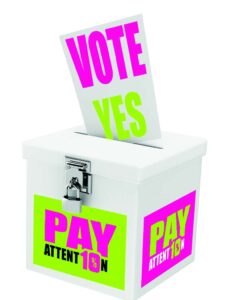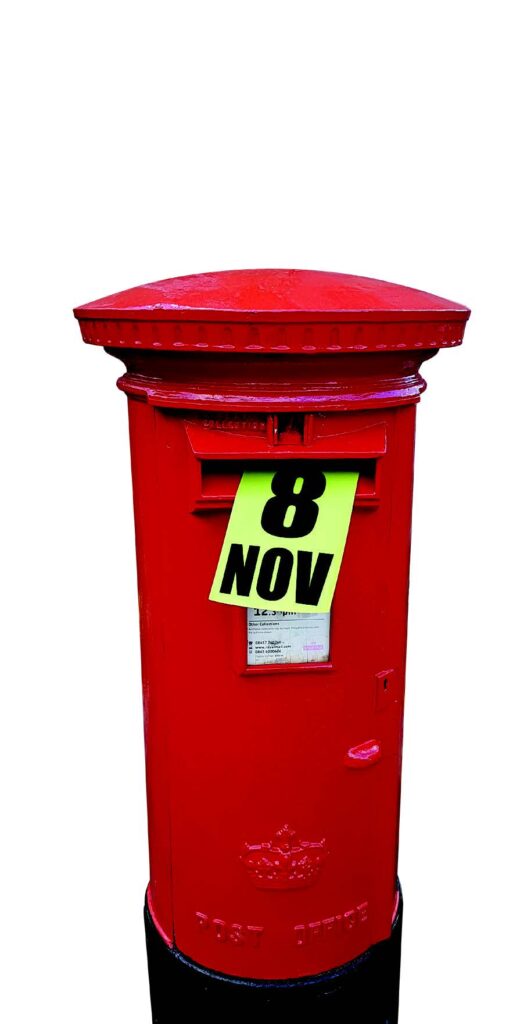
Make sure you use your vote!
With the overwhelming result in the recent consultative ballot, where 94% of members rejected the 5% pay offer and 91% backed a move to strike action, the EIS is now proceeding with plans for a statutory strike ballot.
All EIS members eligible to vote in this ballot will shortly receive a ballot pack from our appointed ballot service. This pack will include a ballot paper, details on how to vote, information supporting the EIS pay campaign detailing why you should back strike action, and a pre-paid envelope for returning your voting paper.
What is a statutory ballot?
A statutory ballot is a formal ballot to enable industrial action. Before strike action can be taken, any trade union must conduct a statutory ballot of its members, in line with trade union legislation.
What legislation governs the ballot?
The Trade Union Act (2016), introduced under the UK Conservative government, places many excessive restrictions on trade unions, including the ways in which industrial action ballots are conducted.
What are the restrictions on ballots?
Under the law, statutory strike ballots can only be conducted by post. This is designed to slow down and otherwise hinder the conduct of ballots. The law also imposes highly restrictive thresholds to be met in ballots before strike action can be taken.
What are the thresholds?
As schools are considered an essential public service, two ballot thresholds must be met for strike action to be taken. Firstly, ballot turnout amongst eligible members must be at least 50%. Secondly, at least 40% of all members eligible to vote must back strike action.
What does that mean in practice?
The double threshold is challenging, and some trade unions have fallen short of achieving a mandate for strike action because of low turnouts. The double threshold means that, for example, if a ballot turnout is 50%, then at least 80% of those voting would have to vote for strike action to hit the second threshold (i.e. 40% of the total membership backing strike action).
Wasn’t the recent consultative ballot comfortably above these thresholds?
Yes, the turnout in the recent EIS consultative ballot was 78%, with 91% of members voting for strike action. Should this level of turnout and support be replicated, the EIS would comfortably achieve the ballot thresholds for strike action.
What are we being asked to vote for in the statutory ballot?
The 5% pay offer has now been formally rejected by teaching unions. You are now being asked to vote in favour of strike action in pursuit of an improved pay settlement for teachers. The EIS strongly recommends that you vote Yes to strike action.
When will I receive my ballot paper?
Ballot papers are scheduled to be posted from Wednesday 12th October, so you should receive your ballot paper at your registered home address shortly after this date.
What should I do if I haven’t received my ballot paper by 15th October?
You should contact the EIS membership department urgently via ballot@eis.org.ukand include your name, membership number, school base and home address. We will then contact our ballot service to ensure that a new ballot paper is sent to you.
Can I vote online?
Unfortunately, no. The EIS would love to offer an online voting option but, as this is a statutory strike ballot, we must comply with the UK government legislation on trade union ballots. This stipulates that all voting in the ballot must take place by post.
When should I vote?
The ballot opens on Wednesday 12 October, when ballot papers will be issued. You can vote as soon as you receive your ballot paper, by completing and returning your ballot in the pre-paid envelope provided. The EIS would strongly encourage members to vote as soon as they can, upon receipt of their ballot paper. We also ask that members on Twitter publicise that they’ve voted using #PayAttentionPosted
What happens if I don’t vote?
Under trade union law, those not voting in the ballot will effectively be voting no to strike action. Not voting will undermine efforts to secure a strong ballot result, and weaken the union’s negotiating position. It is essential that all members use their vote and vote yes to strike action.
When does the ballot close?
The ballot will close on Tuesday 8 November, so all completed postal ballots must be received by this date. The results will be tallied and the result announced as soon as possible thereafter.
What happens after the ballot closes?
EIS Executive will consider the result of the ballot and determine the next steps to be taken. Should the ballot deliver a mandate for strike action, the Executive will agree and announce an initial programme of strike action shortly after the ballot closes.
When would strike action take place?
Notice of strike action requires to be served on employers 14 days before strike action is due to begin. Based on the ballot closing date and statutory notice period, the earliest that strike action could take place is in the week ending 25 November.
If we back strike action, will there definitely be a strike?
The delivery of a legal mandate to strike would greatly strengthen the union’s negotiating position with employers and government. We will use this to seek further improvements in the pay offer. Should no satisfactory offer be forthcoming, the EIS would then call on members to take strike action.
I still have questions – who should I speak to?
Speak to your school Rep or Local Association Secretary about the ballot and the ongoing pay campaign. You can also find more information on the EIS website: www.eis.org.uk
This is not just about pay. This is about trade unionists, representing the people of the workforces that keep this country going, registering our protest at a cost-of-living crisis that we did not create. The cost of living crisis was created by unscrupulous and greedy capitalists. Many of those are actually benefitting from this crisis. We did not cause it, and we will not pay for it. A wage increase that does not rise with inflation is a pay cut. It’s as simple as that. We will not pay for the cost-of-living crisis with a pay cut.
The UK Tory government have already made sure that industrial action is a bureaucratic nightmare, yet in the face of that, trade unions, all around the country are exercising their right to take action. The tide is turning. We will no longer sit back and be told that we need to bear the economic burden for people who certainly didn’t have us at the heart of their decision making. Anti-trade union thresholds are being met and smashed all around the country. Enough is most definitely enough. The people are speaking. It’s time for those decision makers, in Westminster, Holyrood and COSLA to listen up!
Andrene Bamford, EIS President

Time for COSLA and the Scottish Government to step up – and pay up
The recent formal rejection of the pay offer, and the declaration of a dispute with local authority employers, were important steps in the continuing campaign for a fair pay settlement for Scotland’s teachers. The message from our consultative ballot was crystal clear – Scotland’s teachers have had enough and are prepared to take strike action over pay. The EIS is listening to its members, and will now move forward with a statutory ballot to enable strike action in schools later this autumn.
Scotland’s local authorities and the Scottish Government must significantly up their offer to Scotland’s teachers if strike action is to be avoided. Our overwhelming consultative ballot result smashed through the restrictive strike thresholds set by the UK government’s anti-trade union legislation, and the EIS is confident that a similar result will be delivered in the forthcoming statutory strike ballot. It is not too late for strike action to be avoided but, for this to happen, COSLA and the Scottish Government must step up and deliver a much improved offer.
Andrea Bradley, EIS General Secretary
